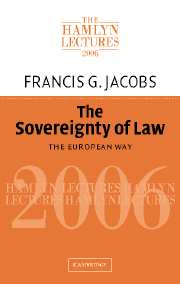Book contents
- Frontmatter
- Contents
- The Hamlyn Trust
- The Hamlyn Lectures
- Preface
- 1 Introduction
- 2 The rule of law in Europe
- 3 The European Convention on Human Rights and the rule of law
- 4 The European Union and the rule of law
- 5 Fundamental values
- 6 Courts and free markets
- 7 The European Union today: some achievements
- 8 The European Union today: some problems
- Afterword
- Index
8 - The European Union today: some problems
Published online by Cambridge University Press: 29 July 2009
- Frontmatter
- Contents
- The Hamlyn Trust
- The Hamlyn Lectures
- Preface
- 1 Introduction
- 2 The rule of law in Europe
- 3 The European Convention on Human Rights and the rule of law
- 4 The European Union and the rule of law
- 5 Fundamental values
- 6 Courts and free markets
- 7 The European Union today: some achievements
- 8 The European Union today: some problems
- Afterword
- Index
Summary
So far I have concentrated on some of the strengths of the European project. Now I should like to look at some of the concerns that have been expressed, and some of the questions that arise.
I will take three: loss of sovereignty, excessive regulation and over-ambition. All have some relation to the overall theme of the rule of law.
The loss of sovereignty
The concern over loss of sovereignty has, I suggest, some dubious aspects, but others which are better founded.
The notion of the sovereign State is outmoded. It has been replaced, I would suggest, by two main ideas. First, there is now, and increasingly, an allocation of powers, which are divided, in different realms, among different levels of government: local, national, regional, global. This is true, very obviously, in political terms, but it is also increasingly true in legal terms.
In legal terms, the last word, on certain matters of international security, now rests with the United Nations Security Council; on many aspects of international trade, with the World Trade Organization and its Court (the ‘Appellate Body’). In Europe, the last word on human rights is often for the European Court of Human Rights; the last word on the European internal market is for the European Court of Justice.
Second, the formerly sovereign States can effectively act jointly by sharing their powers.
- Type
- Chapter
- Information
- The Sovereignty of LawThe European Way, pp. 137 - 152Publisher: Cambridge University PressPrint publication year: 2007

